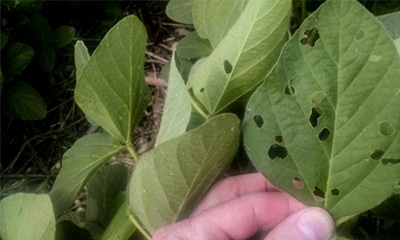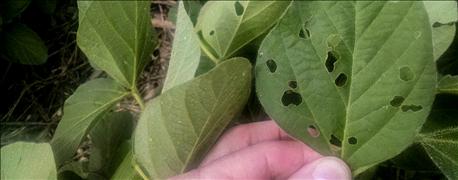July 22, 2016

July is when a variety of soybean defoliators start to show up in Nebraska soybean fields. While there haven't been any reports of significant soybean defoliation as of mid-July, someone will likely begin to see some soon. So, let's review our soybean insect defoliation recommendations.
Many insects defoliate soybeans. In fact, in most cases a complex of soybean defoliators are reported as doing the damage. The most common single pest reported is generally first-generation bean leaf beetle, but there are also numerous grasshoppers and a variety of caterpillars that eat soybean leaves. In Nebraska, it's common for several defoliators to be present at the same time.

Figure 1: Starting in July, growers are apt to start finding soybean defoliation from a number of insects. In Nebraska, it's not uncommon for growers to find several defoliators present at the same time.
Because we often find several species of defoliators in most fields, insect counts typically are not used to determine whether to treat. Instead, percent of defoliation is used.
Insect defoliation of soybean
Soybean plants can tolerate significant defoliation. In fact, when holes are chewed in the top of the canopy, light gets deeper in the canopy and the inner leaves can increase their photosynthetic rate. Even with defoliation, if the remaining leaves are still intercepting at least 90% of the incident light, soybean can compensate for loss of leaf tissue.
Canopy size is important when making treatment decisions. Small soybean canopies cannot tolerate as much defoliation as large canopies.
Another consideration is when defoliation occurs. Unless severe, defoliation during vegetative stages usually doesn't cause significant yield loss. The reproductive stages are more sensitive. Because Nebraska soybeans are entering the reproductive stages, it's important to start checking fields now.

Figure 2: Levels of soybean defoliation are illustrated on this chart from the University of Nebraska's CropWatch website. Injury is often overestimated, and using a chart like this helps determine the average level of defoliation.
Growing conditions are a final factor. When environmental conditions are favorable for soybean development (e.g. adequate water), plants have a greater capacity for regrowth and compensation.
Making a management decision
For soybeans still in vegetative stages (pre-flowering), consider treatment if insects are present and feeding, and defoliation will exceed 30%. When soybeans are in the reproductive stages, consider treatment if insect defoliators are present and defoliation is expected to exceed 20%. These percentages can vary 5% or more according to the stage or type of insect(s) present, environmental conditions, the specific stage of the soybean, and the size and condition of the canopy. Experience will have to be your guide when making a final decision.
Defoliation is difficult to estimate and is almost always overestimated. That's because the injury is so dramatic, and all parts of the canopy often are not considered when making defoliation estimates. Some insect species primarily feed in the upper part of the canopy (e.g., bean leaf beetle), and some feed lower in the canopy (e.g., looper caterpillars). Different portions of the canopy will suffer different levels of injury. Therefore, when estimating defoliation, the entire canopy — not just the injured portion — must be considered.
In order to predict if defoliation will exceed 30% (vegetative soybean) or 20% (reproductive soybean), the current injury must be estimated. The following steps are suggested:
• Remove a trifoliolate leaf from the top, middle, and lower third of 10 randomly selected plants.
• Discard the most- and least-damaged leaflets from each trifoliolate leaf. This will leave you with 30 leaflets.
• Compare the 30 leaflets with the leaflets in Figure 2 and determine the average level of defoliation.
• Repeat steps 1-3 at four or more randomly selected locations in the field.
If defoliation approaches 30% in vegetative-stage soybean, or 20% in reproductive-stage soybean, treatment may be warranted if the insects are actively feeding and defoliation is expected to increase.
If treatment is warranted, identify the primary defoliating insect(s) and use the insecticide guides on the UNL CropWatch soybean insect pests web page, cropwatch.unl.edu/insect/soybeanpestmgt. Most commonly used foliar insecticides are effective against most soybean defoliators.
For additional information, contact Thomas Hunt, University of Nebraska Extension entomologist, at [email protected]; Keith Jarvi, Extension educator, at [email protected]; Wayne Ohnesorg, Extension educator, at [email protected]; or Nathan Mueller, Extension educator, at [email protected].
Source: UNL CropWatch
You May Also Like




